Speed Climbing Analysis System Based on Spatial Positioning and Posture Recognition: Design and Effectiveness Assessment
Abstract
1. Introduction
2. Materials and Methods
2.1. Experimental Design
2.2. Participants
2.3. System Setup and Data Acquisition
2.3.1. Three-Dimensional Trajectory Measurement
2.3.2. Motion Posture Capture
2.3.3. System Calibration
2.3.4. Data Fusion
2.4. Statistical Analysis
3. Results
3.1. System Validation Experiments
3.2. Practical Use Experiments
3.2.1. Statistical Analysis of Climbing Performance
3.2.2. Group-Optimal Path Analysis
4. Discussion
5. Conclusions
Author Contributions
Funding
Institutional Review Board Statement
Informed Consent Statement
Data Availability Statement
Conflicts of Interest
References
- Winkler, M.; Künzell, S.; Augste, C. Competitive Performance Predictors in Speed Climbing, Bouldering, and Lead Climbing. J. Sports Sci. 2023, 41, 736–746. [Google Scholar] [CrossRef]
- De La Cruz, V.M.; Carranza, V.R.; González Ravé, J.M. Road to Paris 2024: Force-Velocity Profile in Different Speed Climbers’ Abilities. Biol. Sport 2024, 41, 131–137. [Google Scholar] [CrossRef] [PubMed]
- Lutter, C.; Tischer, T.; Schöffl, V.R. Olympic Competition Climbing: The Beginning of a New Era—A Narrative Review. Br. J. Sports Med. 2021, 55, 857–864. [Google Scholar] [CrossRef]
- Ehiogu, U.D.; Krawczyk, M.; Tallent, J. Strength and Conditioning Considerations for Speed Climbing. Strength Cond. J. 2022, 45, 259–271. [Google Scholar] [CrossRef]
- Pandurevic, D.; Sutor, A.; Hochradel, K. Towards Statistical Analysis of Predictive Parameters in Competitive Speed Climbing. Sports Eng. 2023, 26, 42. [Google Scholar] [CrossRef]
- Orth, D.; Davids, K.; Seifert, L. Coordination in Climbing: Effect of Skill, Practice and Constraints Manipulation. Sports Med. 2016, 46, 255–268. [Google Scholar] [CrossRef]
- Langer, K.; Simon, C.; Wiemeyer, J. Physical Performance Testing in Climbing—A Systematic Review. Front. Sports Act. Living 2023, 5, 1130812. [Google Scholar] [CrossRef]
- Draper, N.; Dickson, T.; Blackwell, G.; Fryer, S.; Priestley, S.; Winter, D.; Ellis, G. Self-Reported Ability Assessment in Rock Climbing. J. Sports Sci. 2011, 29, 851–858. [Google Scholar] [CrossRef]
- Seifert, L.; Cordier, R.; Orth, D.; Courtine, Y.; Croft, J.L. Role of Route Previewing Strategies on Climbing Fluency and Exploratory Movements. PLoS ONE 2017, 12, e0176306. [Google Scholar] [CrossRef]
- Legreneur, P.; Rogowski, I.; Durif, T. Kinematic Analysis of the Speed Climbing Event at the 2018 Youth Olympic Games. Comput. Methods Biomech. Biomed. Eng. 2019, 22, S264–S266. [Google Scholar] [CrossRef]
- Grant, S.; Hynes, V.; Whittaker, A.; Aitchison, T. Anthropometric, Strength, Endurance and Flexibility Characteristics of Elite and Recreational Climbers. J. Sports Sci. 1996, 14, 301–309. [Google Scholar] [CrossRef] [PubMed]
- Abt, G.; Jobson, S.; Morin, J.-B.; Passfield, L.; Sampaio, J.; Sunderland, C.; Twist, C. Raising the Bar in Sports Performance Research. J. Sports Sci. 2022, 40, 125–129. [Google Scholar] [CrossRef] [PubMed]
- Badiola-Bengoa, A.; Mendez-Zorrilla, A. A Systematic Review of the Application of Camera-Based Human Pose Estimation in the Field of Sport and Physical Exercise. Sensors 2021, 21, 5996. [Google Scholar] [CrossRef] [PubMed]
- Yan, M.; Wang, X.; Dai, Y.; Shen, S.; Wen, C.; Xu, L.; Ma, Y.; Wang, C. CIMI4D: A Large Multimodal Climbing Motion Dataset under Human-Scene Interactions. In Proceedings of the 2023 IEEE/CVF Conference on Computer Vision and Pattern Recognition (CVPR), Vancouver, BC, Canada, 17–24 June 2023; IEEE: New York, NY, USA, 2023; pp. 12977–12988. [Google Scholar]
- Richter, J.; Beltrán, R.B.; Heinkel, U. Camera-Based Climbing Analysis for a Therapeutic Training System. Curr. Dir. Biomed. Eng. 2020, 6, 20202010. [Google Scholar] [CrossRef]
- Pandurevic, D.; Draga, P.; Sutor, A.; Hochradel, K. Analysis of Competition and Training Videos of Speed Climbing Athletes Using Feature and Human Body Keypoint Detection Algorithms. Sensors 2022, 22, 2251. [Google Scholar] [CrossRef]
- Chen, R.; Liu, Z.; Li, Y.; Gao, J. A Time-Motion and Error Analysis of Speed Climbing in the 2019 IFSC Speed Climbing World Cup Final Rounds. Int. J. Environ. Res. Public Health 2022, 19, 6003. [Google Scholar] [CrossRef]
- Askari Hosseini, S.; Wolf, P. Performance Indicators in Speed Climbing: Insights from the Literature Supplemented by a Video Analysis and Expert Interviews. Front. Sports Act. Living 2023, 5, 1304403. [Google Scholar] [CrossRef]
- Reveret, L.; Chapelle, S.; Quaine, F.; Legreneur, P. 3D Visualization of Body Motion in Speed Climbing. Front. Psychol. 2020, 11, 2188. [Google Scholar] [CrossRef]
- Iguma, H.; Kawamura, A.; Kurazume, R. A New 3D Motion and Force Measurement System for Sport Climbing. In Proceedings of the 2020 IEEE/SICE International Symposium on System Integration (SII), Honolulu, HI, USA, 12–15 January 2020; IEEE: New York, NY, USA, 2020; pp. 1002–1007. [Google Scholar]
- Shiao, Y.; Chen, G.-Y.; Hoang, T. Three-Dimensional Human Posture Recognition by Extremity Angle Estimation with Minimal IMU Sensor. Sensors 2024, 24, 4306. [Google Scholar] [CrossRef]
- Paijens, A.F.M.; Huang, L.; Al-Jumaily, A.M. Measurement of the Positions of Light Sensors on a Mobile Frame Being Tracked with a Lighthouse Localization System. Sens. Actuators A Phys. 2021, 331, 112979. [Google Scholar] [CrossRef]
- Vrzáková, H.; Koskinen, J.; Andberg, S.; Lee, A.; Amon, M.J. Towards Automatic Object Detection and Activity Recognition in Indoor Climbing. Sensors 2024, 24, 6479. [Google Scholar] [CrossRef]
- Xie, Y.; Li, S.; Lin, P. Producing a Standard Dataset of Speed Climbing Training Videos Using Deep Learning Techniques. arXiv 2023, arXiv:2305.13858. [Google Scholar] [CrossRef]
- Kosourikhina, V.; Kavanagh, D.; Richardson, M.J.; Kaplan, D.M. Validation of Deep Learning-Based Markerless 3D Pose Estimation. PLoS ONE 2022, 17, e0276258. [Google Scholar] [CrossRef] [PubMed]
- Mathis, A.; Mamidanna, P.; Cury, K.M.; Abe, T.; Murthy, V.N.; Mathis, M.W.; Bethge, M. DeepLabCut: Markerless Pose Estimation of User-Defined Body Parts with Deep Learning. Nat. Neurosci. 2018, 21, 1281–1289. [Google Scholar] [CrossRef] [PubMed]
- Cao, Z.; Hidalgo, G.; Simon, T.; Wei, S.-E.; Sheikh, Y. OpenPose: Realtime Multi-Person 2D Pose Estimation Using Part Affinity Fields. IEEE Trans. Pattern Anal. Mach. Intell. 2021, 43, 172–186. [Google Scholar] [CrossRef] [PubMed]
- Bazarevsky, V.; Grishchenko, I.; Raveendran, K.; Zhu, T.; Zhang, F.; Grundmann, M. BlazePose: On-Device Real-Time Body Pose Tracking. arXiv 2020, arXiv:2006.10204. [Google Scholar] [CrossRef]
- Stenum, J.; Rossi, C.; Roemmich, R.T. Two-Dimensional Video-Based Analysis of Human Gait Using Pose Estimation. PLoS Comput. Biol. 2021, 17, e1008935. [Google Scholar] [CrossRef]
- Zheng, C.; Wu, W.; Chen, C.; Yang, T.; Zhu, S.; Shen, J.; Kehtarnavaz, N.; Shah, M. Deep Learning-Based Human Pose Estimation: A Survey. ACM Comput. Surv. 2020, 56, 1–37. [Google Scholar] [CrossRef]
- Nogueira, A.F.R.; Oliveira, H.P.; Teixeira, L.F. Markerless Multi-View 3D Human Pose Estimation: A Survey. Image Vis. Comput. 2025, 155, 105437. [Google Scholar] [CrossRef]
- Mulder, T.; Hochstenbach, J. Adaptability and Flexibility of the Human Motor System:Implications for Neurological Rehabilitation. Neural Plast. 2001, 8, 131–140. [Google Scholar] [CrossRef]
- Yasukouchi, A. A Perspective on the Diversity of Human Adaptability. J. Physiol. Anthropol. 2005, 24, 243–247. [Google Scholar] [CrossRef][Green Version]
- Glazier, P.S.; Davids, K.; Bartlett, R. Dynamical systems theory: A relevant framework for performance-oriented sports biomechanical research. Sportscience 2003, 7, 2–18. [Google Scholar][Green Version]
- International Federation of Sport Climbing (IFSC). Speed Licence Rules—Speed Walls. IFSC. 2022. Available online: https://www.ifsc-climbing.org/ (accessed on 10 April 2025).
- Ikbal, M.S.; Ramadoss, V.; Zoppi, M. Dynamic Pose Tracking Performance Evaluation of HTC Vive Virtual Reality System. IEEE Access 2021, 9, 3798–3815. [Google Scholar] [CrossRef]
- Niehorster, D.C.; Li, L.; Lappe, M. The Accuracy and Precision of Position and Orientation Tracking in the HTC Vive Virtual Reality System for Scientific Research. i-Perception 2017, 8, 2041669517708205. [Google Scholar] [CrossRef]
- Borges, M.; Symington, A.; Coltin, B.; Smith, T.; Ventura, R. HTC Vive: Analysis and Accuracy Improvement. In Proceedings of the 2018 IEEE/RSJ International Conference on Intelligent Robots and Systems (IROS), Madrid, Spain, 1–5 October 2018; IEEE: New York, NY, USA, 2018; pp. 2610–2615. [Google Scholar]
- Astad, M.A.; Hauan Arbo, M.; Grøtli, E.I.; Tommy Gravdahl, J. Vive for Robotics: Rapid Robot Cell Calibration. In Proceedings of the 7th International Conference on Control, Mechatronics and Automation (ICCMA), Delft, The Netherlands, 6–8 November 2019; pp. 151–156. [Google Scholar]
- Němá, K.; Gilić, B.; Vrdoljak, D.; Kozák, T.; Berta, P.; Kováč, M. Physical Fitness of Elite Youth Sports Climbers: Gender Differences and Correlates of Climbing Ability. Biomed. Hum. Kinet. 2025, 17, 197–207. [Google Scholar] [CrossRef]
- Elias, P.; Skvarlova, V.; Zezula, P. SPEED21: Speed Climbing Motion Dataset. In Proceedings of the 4th International Workshop on Multimedia Content Analysis in Sports, Virtual, 20 October 2021; ACM: New York, NY, USA, 2021; pp. 43–50. [Google Scholar]
- Mora-Fernandez, A.; Argüello-Arbe, A.; Tojeiro-Iglesias, A.; Latorre, J.A.; Conde-Pipó, J.; Mariscal-Arcas, M. Nutritional Assessment, Body Composition, and Low Energy Availability in Sport Climbing Athletes of Different Genders and Categories: A Cross-Sectional Study. Nutrients 2024, 16, 2974. [Google Scholar] [CrossRef] [PubMed]
- Carroll, C. Female Excellence in Rock Climbing Likely Has an Evolutionary Origin. Curr. Res. Physiol. 2021, 4, 39–46. [Google Scholar] [CrossRef]
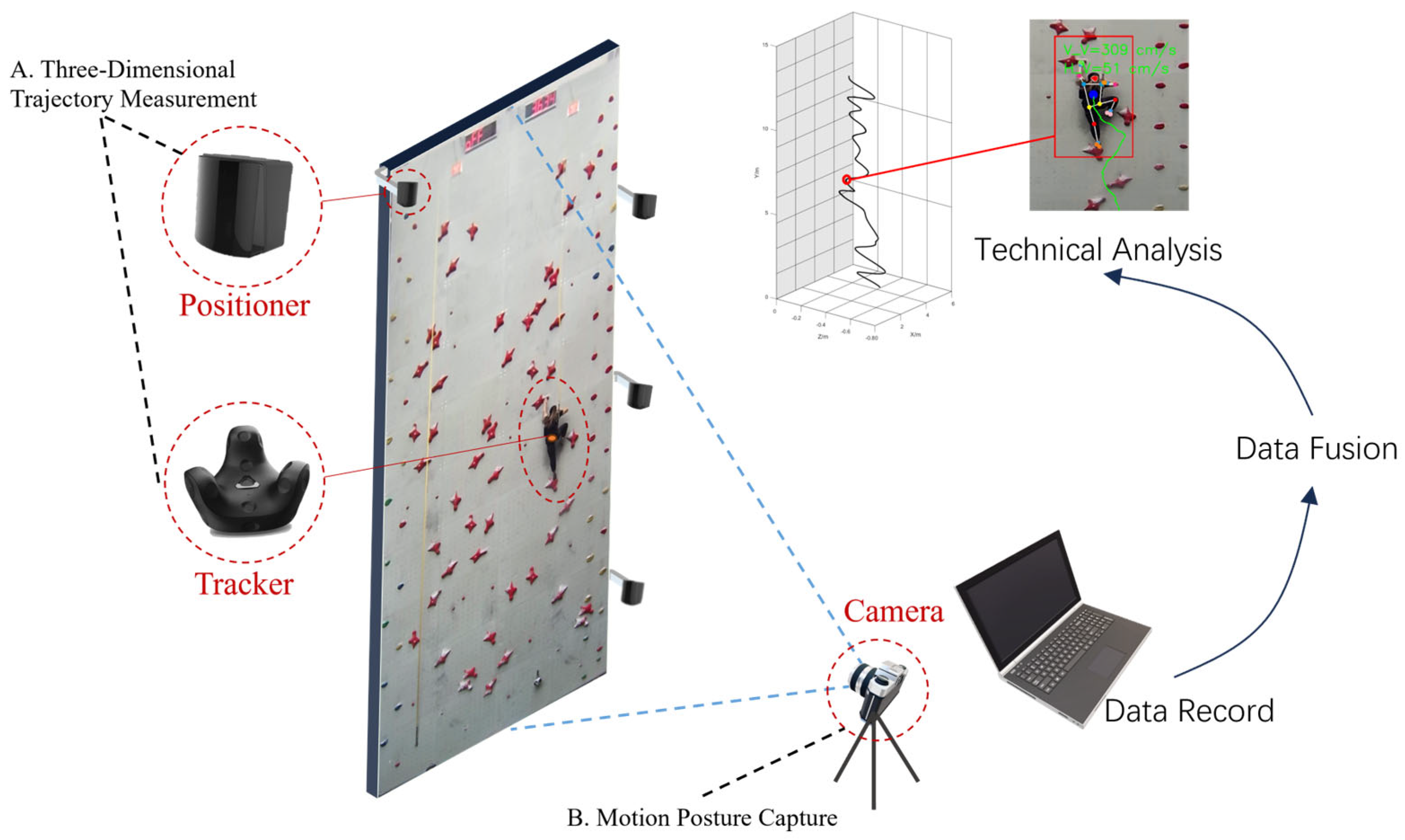
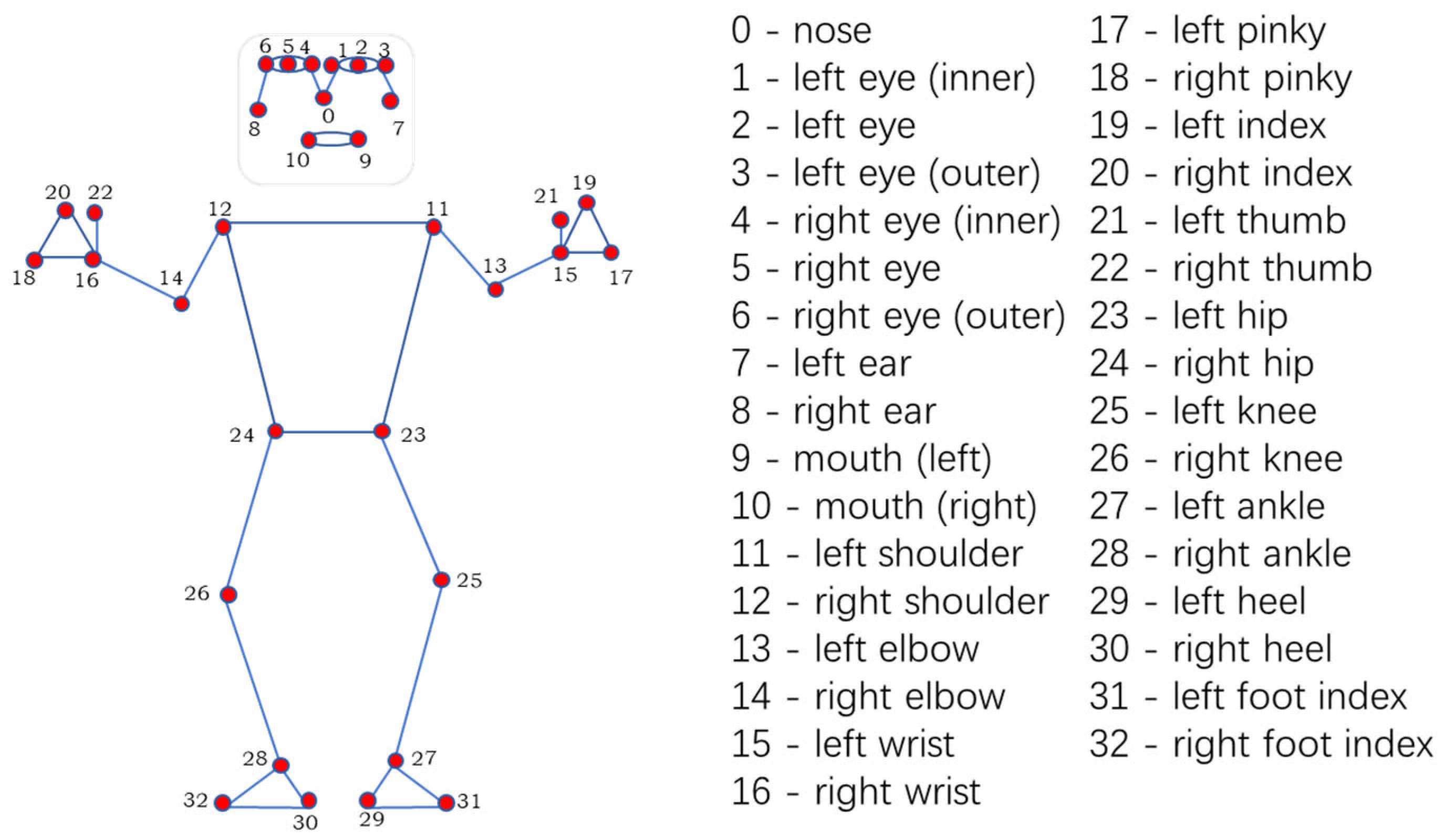

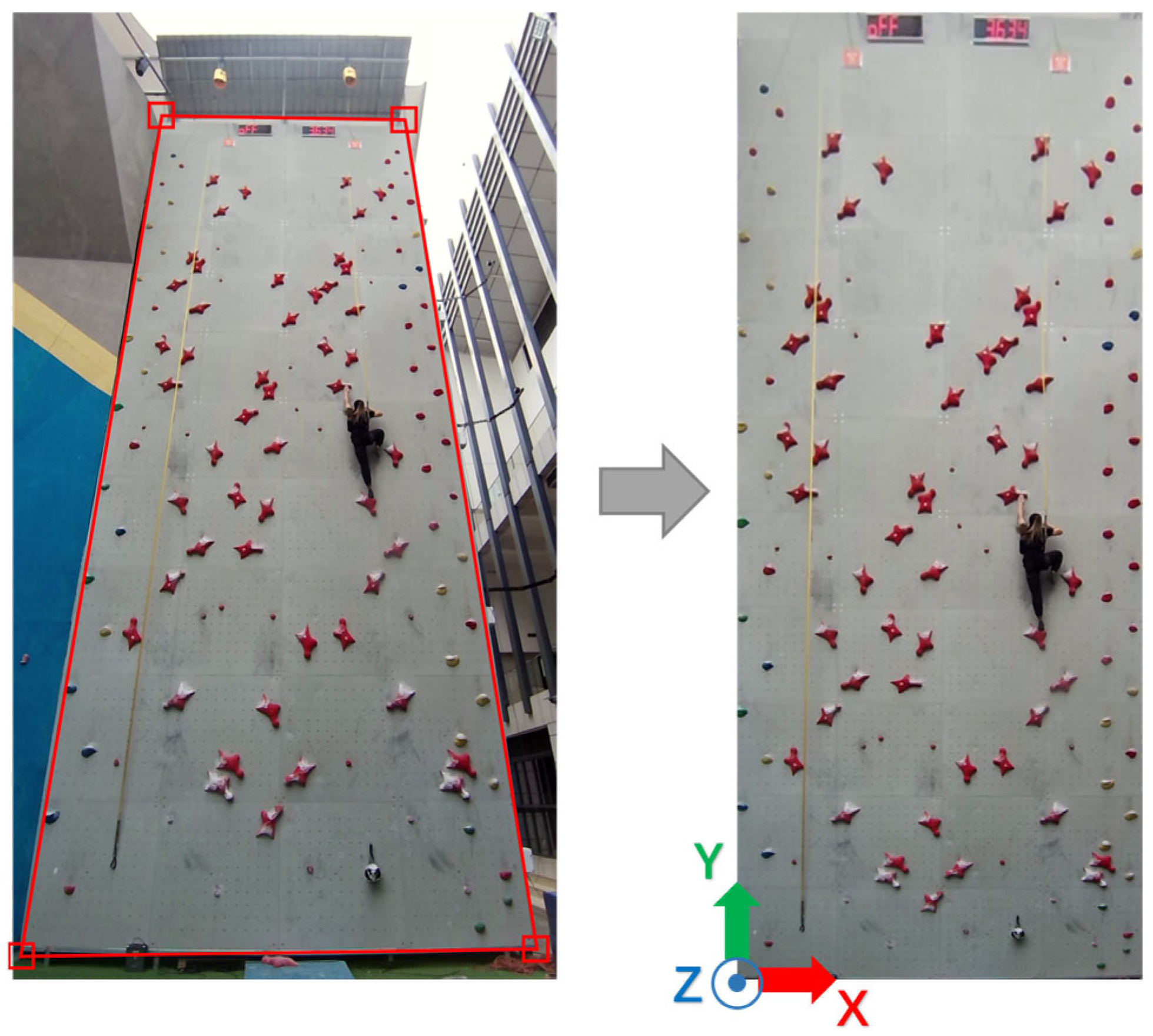

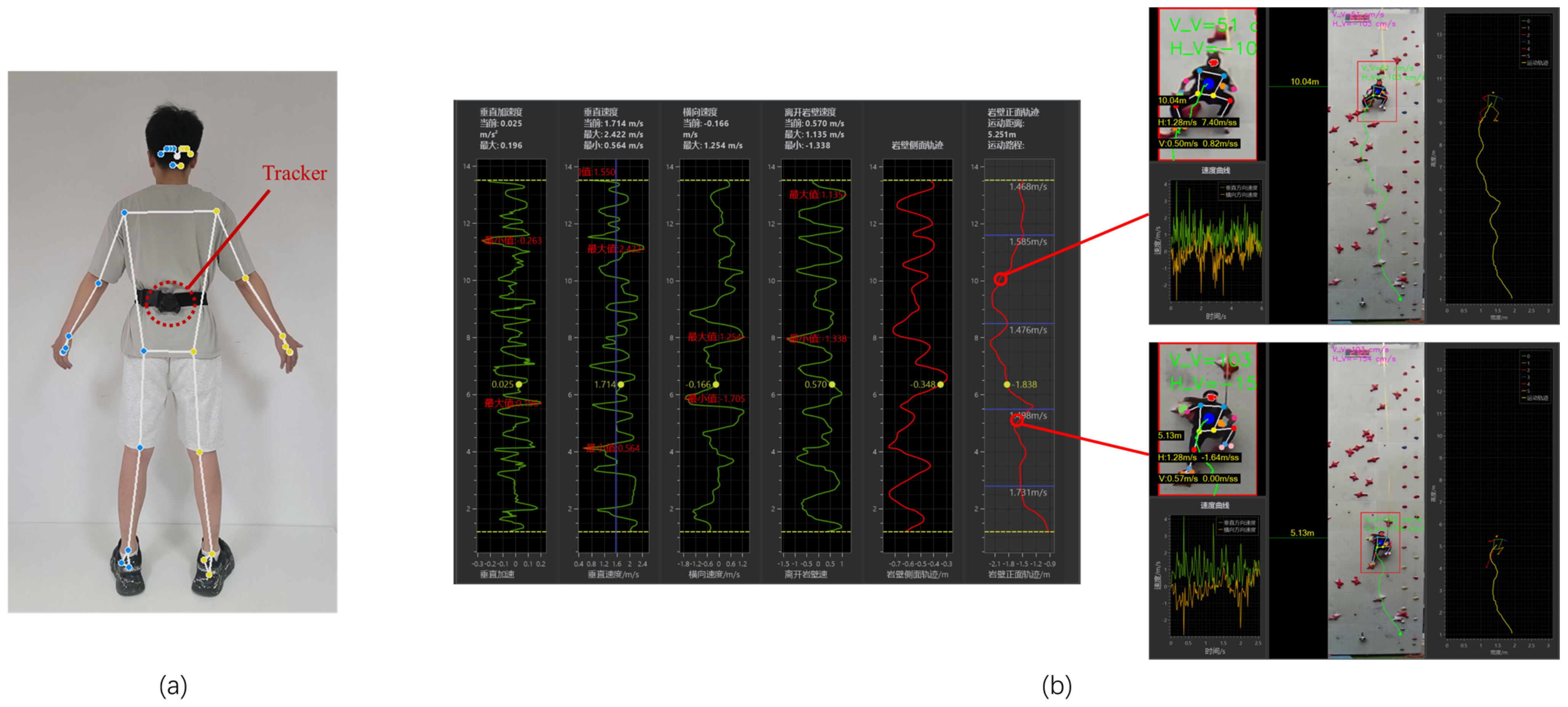

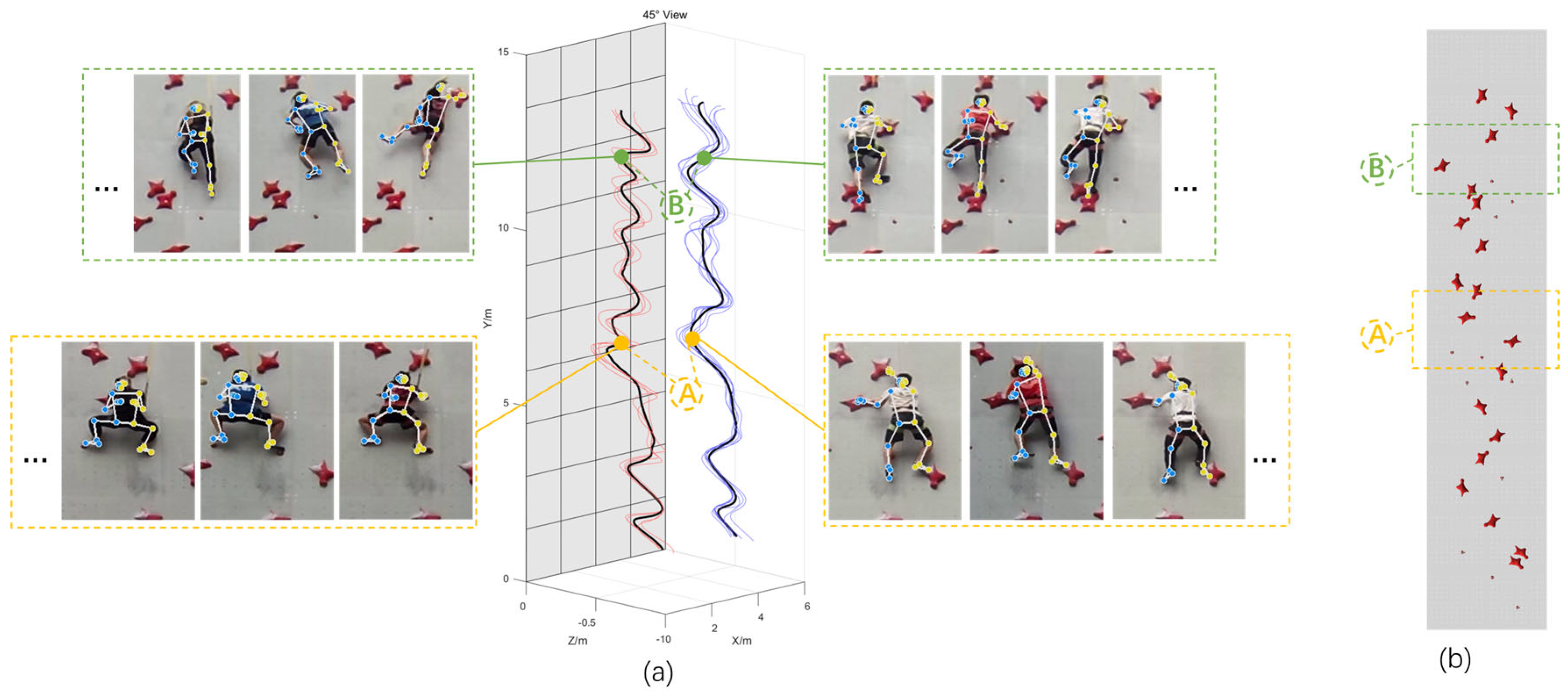
| Characteristic | Male (n = 8) | Female (n = 4) | Total (n = 12) |
|---|---|---|---|
| Age (years) | 21.5 ± 2.2 | 23 ± 2.1 | 22.0 ± 2.2 |
| Height (m) | 1.70 ± 0.03 | 1.66 ± 0.04 | 1.69 ± 0.04 |
| Weight (kg) | 63.6 ± 4.5 | 58.7 ± 3.2 | 62.3 ± 4.6 |
| Experience (years) | 2.4 ± 1.1 | 3.7 ± 1.3 | ≥1 year |
| Metric | Male (mean ± SD) | Female (mean ± SD) | t (df) | p | Cohen’s d |
|---|---|---|---|---|---|
| Climb time (s) | 5.97 ± 0.21 | 6.65 ± 0.31 | 4.28 (10) | 0.002 | 2.47 |
| trajectory inflections | 10.1 ± 0.59 | 12 ± 0.71 | 5.66 (10) | <0.001 | 3.27 |
| Mean Deviation from Optimal (m) | 0.157 ± 0.007 | 0.190 ± 0.012 | 6.46 (10) | <0.001 | 3.73 |
Disclaimer/Publisher’s Note: The statements, opinions and data contained in all publications are solely those of the individual author(s) and contributor(s) and not of MDPI and/or the editor(s). MDPI and/or the editor(s) disclaim responsibility for any injury to people or property resulting from any ideas, methods, instructions or products referred to in the content. |
© 2025 by the authors. Licensee MDPI, Basel, Switzerland. This article is an open access article distributed under the terms and conditions of the Creative Commons Attribution (CC BY) license (https://creativecommons.org/licenses/by/4.0/).
Share and Cite
Huang, P.; Huang, T.; Xu, Z.; Zhang, Y.; Wang, H. Speed Climbing Analysis System Based on Spatial Positioning and Posture Recognition: Design and Effectiveness Assessment. Appl. Sci. 2025, 15, 8959. https://doi.org/10.3390/app15168959
Huang P, Huang T, Xu Z, Zhang Y, Wang H. Speed Climbing Analysis System Based on Spatial Positioning and Posture Recognition: Design and Effectiveness Assessment. Applied Sciences. 2025; 15(16):8959. https://doi.org/10.3390/app15168959
Chicago/Turabian StyleHuang, Pingao, Tianzhan Huang, Zhihong Xu, Yuankang Zhang, and Hui Wang. 2025. "Speed Climbing Analysis System Based on Spatial Positioning and Posture Recognition: Design and Effectiveness Assessment" Applied Sciences 15, no. 16: 8959. https://doi.org/10.3390/app15168959
APA StyleHuang, P., Huang, T., Xu, Z., Zhang, Y., & Wang, H. (2025). Speed Climbing Analysis System Based on Spatial Positioning and Posture Recognition: Design and Effectiveness Assessment. Applied Sciences, 15(16), 8959. https://doi.org/10.3390/app15168959





